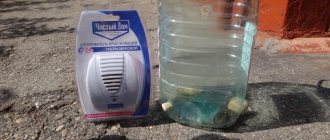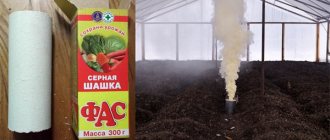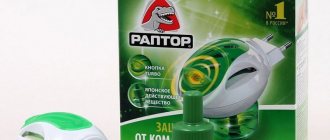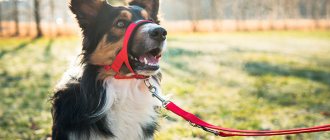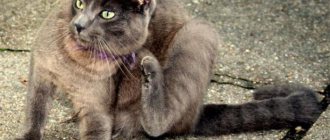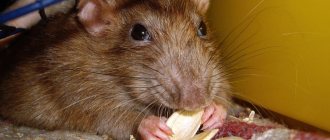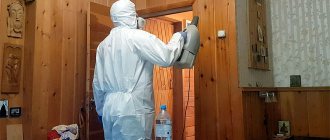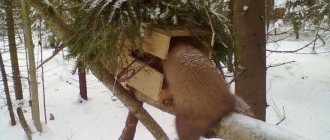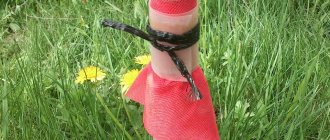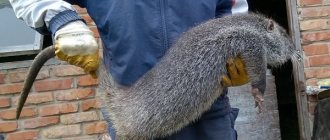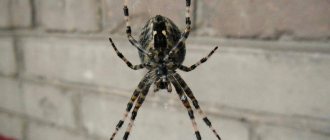The first working and tested version. By using a microcontroller, it was possible to create a compact circuit with a reasonable minimum of parts. The characteristics of the electric shepherd are given below:
- Output voltage from 6 to 12 kilovolts (depending on the transformer);
- Power from 1.8 to 9 joules (depending on the capacitor);
- Pulse frequency 1 time per second (working mode) or 0.8 times per second (for taming animals), selectable.
- Supply voltage is from 10.5 to 14 volts, works both from the battery and from the power supply;
- Protection of the battery from deep discharge (when the voltage drops, the device turns off completely);
- Overturn protection;
- Automatic adjustment to the used capacitor;
- Light indication of pulses;
- Light indication of battery discharge.
Principle of operation
In general, the operation of the device consists of charging capacitor C8 to a voltage of 600 volts and discharging it onto the primary winding of the output transformer with thyristor U4 at certain intervals (1-0.8 sec). Next, let's look at the diagram in more detail:
Reversal protection is implemented on P-channel transistor Q1, which is much more efficient than a diode due to the lower voltage drop across the open channel.
Power is supplied to the microcontroller through the linear regulator U2 and capacitor C2. Blocking capacitor C1 has a low ESR and high ripple current; it is highly undesirable to change it to something of unknown origin.
The LED indication light is connected to the output comb through resistor R1.
A voltage divider is assembled on resistors R4, R5 with smoothing capacitor C3 to control the supply voltage to the battery.
The PWM and thyristor opening signals from the microcontroller are sent to the driver through resistors R2 and R3. From the driver to the thyristor gate, the signal is supplied through resistor R8, and to the gate of transistor Q2 through resistor R7. Fast discharge of the transistor gate is provided by diode D1. If soldering is difficult (due to size), the diode can be taken in a larger housing.
A detector operates on elements R6, R9, C7, monitoring the end of the current in the transformer of the high-voltage converter to ensure a quasi-resonant operating mode.
Capacitor C5 additionally provides current to the primary winding, thereby unloading C1.
A voltage divider from the discharge capacitor C8 is assembled on elements R10, R11, R13, C6 to control the end of its charge up to 600 volts.
Choke L1 is wound with a 0.8-1.4 mm wire on an air mandrel with a diameter of 10-15 mm in three layers of about 30 turns.
In parallel with the primary winding of the transformer there is a 680 volt varistor, for example, FNR-20K681, FNR-20D681 (or similar), and a film capacitor C9.
Diode D2 performs the function of a rectifier, diode D3 protects the thyristor, D4 protects against reverse emissions from the inductance of the primary winding of the output transformer and inductor.
Important point! Before turning it on for the first time, the trimming resistor R10 must be set to a maximum resistance of 10 kilo-ohms, then, with its help, you should set the voltage to which the capacitor will be charged, i.e. 600 volts. When setting up, be careful and careful; there will be high voltage on the tracks and parts of the board, which can be extremely dangerous.
Under no circumstances should you order transistors, thyristors, drivers, or powerful diodes from China . 99.9% that it will be a fake. High chance of getting the right parts from stores like Platan, Electronics, Chipdeep. But in China you can order sets of resistors and capacitors of size 0805; they cost pennies, but will last for many years.
Reviews
This year we installed an electric shepherd and are very pleased with it! We keep ponies, which were previously quite difficult to keep track of. But now all the problems have disappeared, the animals walk eight hours a day, happy and healthy! It is convenient to carry the structure. I recommend!
Vladimir, 38 years old
To say that we are satisfied with the purchase of this device is to say nothing! Simply a wonderful device that makes life much easier. The cattle are in perfect order, the electric shepherd stands strong and reliably. Before purchasing, it is really important to consult with a specialist to choose the fence that is right for you.
Alexander, 42 years old
We have been using it for more than three years now, and the results are quite satisfactory.
When operated correctly, it is absolutely safe for both livestock and their owners. All our stables are fenced, and not a single horse has yet broken through their boundaries. It is important to pay attention to such an item as grounding. Then everything will function as it should. Anastasia, 38 years old
Some nuances of work
When turned on, the first thing to do is check the supply voltage of the source, which should be within ~10.4-14.4 volts. If this condition is not met, the device blinks the LED 6 times and turns off.
Next, the jumper/button/jumper on the “pulse speed” contacts is checked. If the contacts are open, the device will pulse once per second. If closed - with a frequency of one pulse every 0.8 seconds.
If the source voltage drops to ~10.9 volts, the LED does not blink with each digit, but twice as often, signaling the need to charge/replace the battery.
What is needed to create a device from an ignition coil with your own hands - diagram
- metal wire or mesh (it should not touch the ground);
- poles capable of withstanding high voltage;
- grounded source of high-voltage pulses.
Do not be afraid that the current will harm a person or animal. The impulses will not cause harm and are not life-threatening. Contact with a fence is fraught with the occurrence of inconspicuous sensations and severe discomfort, which will scare away the animal, but will not cause significant harm to its health. Provided that all safety rules are followed. You may also find it useful to learn about what ketosis looks like in cows and what can be done about this problem.
On the video - how to make equipment with your own hands:
Device details
Parts List:
- U1: Microcontroller PIC16F18326 I/SL – 1 pc.
- U2: Linear voltage regulator LM7805 (size TO-220) – 1 pc.
- U3: Driver IR4427 or TC4427 (frame size SOIC-8) – 1 pc.
- U4: Thyristor VS-40TPS12A-M3 (for capacitors 50 µF or less) or BTW69-1200 (for capacitors 50 µF or more) – 1 pc.
- Q1: Transistor IRF5305 – 1 pc.
- Q2: Transistor AOT298L or IRF540N or IRF3710 – 1 pc.
- D1 Diode 1n4148 – (size SOD123) – 1 pc.
- D2, D3: Diode US5M – 2 pcs.
- D4: Diode 10A10 – 1 pc.
- LED: Blue LED 3 mm in diameter (this is what provides the brightest flashes) – 1 pc.
- R1: Resistor 2k, (size 0805) – 1 pc.
- R2, R3: Resistor 1k, (size 0805) – 2 pcs.
- R4: Resistor 100k, (size 0805) – 1 pc.
- R5: Resistor 22k, (size 0805) – 1 pc.
- R6: Resistor 1k, (power 1-2 watts) – 1 pc.
- R7: Resistor 12-30 Ohm, (size 0805) – 1 pc.
- R8: Resistor 100 Ohm, (size 0805) – 1 pc.
- R9: Resistor 10k, (power 1-2 watts) – 1 pc.
- R10: Trimmer multi-turn resistor 10k – 1 pc.
- R11, R13: Resistor 1M (power 2 watts) – 2 pcs.
- R12: Varistor – 1 pc.
- C1: Capacitor 560 uF 16 volts, A750KS567M1CAAE013 / KEM - 1 pc.
- C2, C4: 1 µF, (frame size 0805) – 1 pc.
- C3: 220 nF, (frame size 0805) – 1 pc.
- C5: 2.2-4.7 uF 100 volts, (film) – 1 pc.
- C6: 1 nF, (frame size 0805) – 1 pc.
- C7: 100 nF 100 volts, (film) – 1 pc.
- C8: 50 uF 450 volts, (starting) – 1 pc.
- C9: 1 uF 630 volts, (film) – 1 pc.
Useful tools at hand
A device made independently will be the most economical option.
Thin welding wire is used as an electric fence. And in order for the animals to see it, they stretch an additional ribbon with flaps. You can immediately provide a wide tape, but you will have to pay for it. True, in the wind it sags, and when wet snow falls, the latter settles and freezes on it, so the conductivity can be reduced.
But for the construction of insulators, you can come up with a lot of means, for example, a wooden stake with plastic bottles (as self-tapping screws), in which two vertical slits are made and a tape is threaded through them. Or you can simply wrap the post with tape. Instead of plastic bottles, some people use other things.
Grounding can be done using an ordinary piece of reinforcement or an iron rod, a little more than a meter in length. It is driven into the ground about a meter. For best performance, it is good to water the soil in dry weather.
To connect the block, conductor and fence, so-called crocodile cords for cars are used. They are cut in two.
If you buy columns, they will not be cheap. A lot of them are usually required, since the maximum distance from each other should be ten meters. But it is advisable to install them even more often. At companies, the posts are made of plastic. It is extremely difficult to find flattering reviews about such devices. They are praised only when the installation is temporary. But for long-term stationary installation, it is better to use wooden ones, made independently.
Of course, it will be more difficult to score them. It will hardly be convenient to hammer with a sledgehammer. And some people get out of this situation by first driving in metal corners and then screwing wooden posts to them. Alternatively, you can purchase a hand drill and use it instead of driving.
In general, if you use the device itself and the electric shepherd generator correctly, it will do its job perfectly. However, when the stallion is overly active, even such an electric fence will not be able to stop him. For such individuals it is better to duplicate the fence. Although the matter will be troublesome and cost a pretty penny, the horse will be saved.
Converter transformer
Core E 25/13/7 N87 (B66317G0250X187) with a gap of 0.25 mm in each half. The wire diameter (by insulation) of the primary is 0.6mm, the secondary is 0.294mm. Winding parameters: first, the primary winding is 12 turns in two wires in one layer, the secondary winding is 210 turns. The minimum diameter of the primary winding wire is 0.5, maximum 0.6mm. The minimum diameter of the secondary winding wire is 0.2, maximum 0.3mm. The width of the tape for insulation between the windings is 15mm, the width of the tape holding the halves of the core together is 5mm. The inductance of the primary winding when measured at a frequency of 1 kHz should be ~22.3uH, the secondary winding should be 6.724mH.
Explanations for the picture:
- Both windings are wound in one direction, the beginning of each winding is marked with a plasticine ball;
- The primary winding wire is evenly distributed along the entire length of the frame;
- The turns are counted on the side opposite to the terminals;
- The primary winding is insulated with tape in one layer, along the edges we make indents with special tape 1.5-2mm wide;
- All layers of the secondary winding are wound with indentations of 1.5-2 mm from the edges of the frame;
- Each layer is insulated with tape in one layer with an overlap of ~4mm;
- We distribute the turns on the last layer evenly along the entire length of the frame, taking into account the gaps.
You should wind it carefully, turn to turn, avoid “blockages” of the wire at the edges, observe indentations, etc. Poor manufacturing will reduce the efficiency of the device and increase the heating of the transformer and transistor.
Kit in store
A generator for electric cattle herding can be purchased in the online store. It comes in foreign and domestic production. Typically the kit includes the following components:
- a unit that supplies voltage, powered by a battery or directly through the network;
- woven ribbon (it comes in different colors);
- pegs for insulators;
- the insulators themselves on which the tape is installed;
- wire for connecting the block and the grounded pin;
- the pin itself.
Electric shepherd output voltage and power calculator
In the article How the electric shepherd works, you can see the table of parameters of the “Olli” shepherds. It shows that the typical output voltage is from 6500 to 9500 volts. Lower values are suitable for animals with short hair, higher values for animals with long hair. Do not forget that the higher the voltage, the lower the current, and vice versa. Since we manufacture the output transformer of the electric shepherd ourselves, we can calculate any required voltage. In the calculation, it should be taken into account that the minimum number of turns of the primary winding should not be less than 25, the optimal is about 35-40. We make the transformer according to the article Transformer for an electric shepherd.
It should also be taken into account that smaller cores require more turns of the primary winding, due to lower inductance. Below is a calculator for calculating the output voltage of an electric shepherd transformer, with which you can select the necessary values.
Consequences of using electric drives for sheep and cows
It is advisable to choose a scheme with a short pulse, because if the pulse is long and quite powerful, the animal will not be able to leave the dangerous place. The unpredictable behavior of the animal (this rule applies to horses to a greater extent) is caused by muscle spasms. The spasm occurs due to too long and powerful an impulse. And if the animal does not leave the dangerous place, then a second impulse will follow and as a result of such an impact it may die.
Different animal species require different characteristics. Therefore, before starting to manufacture an electric fence, you should familiarize yourself with the related information.
Disadvantages of such a generator:
- It works constantly, consumes a lot of energy, which leads to rapid wear of the battery.
- Questionable security. If a large animal comes under attack, the impulse will not cause it much harm, but if a small dog or cat collides with a fence, the animal may die.
There are several different schemes, they differ in wavelength, you can adjust it yourself. But if your skills in working with electricity are not too high, and your knowledge of physics tends to zero, then it is better to familiarize yourself with several diagrams and choose the most understandable one. But what the Schwyz breed of cows looks like and what characteristics exist can be seen by following this link.
Pasture preparation
It is advisable to begin preparatory activities in the spring, when the grass has not begun to grow. This is a favorable time to remove all debris from the ground, as well as last year's weeds.
Preparation rules:
- All bushes must be uprooted; they greatly deplete the soil and prevent the sown herbs from growing normally. In addition, all kinds of parasites quickly multiply in the bushes.
- Old stumps, holes - all this needs to be neutralized, as they contribute to injuries among cows.
- Severely marshy areas are drained and sown with grasses.
- The soil on pastures needs to be fertilized regularly; it is recommended to apply mineral fertilizers and spread last year's cow manure throughout the area.
- Overseeding of plants from the cereal and legume families. This is done to enrich the food supply and increase the density of vegetation. Overseeding is advantageous in that there is no need to till the soil before it. This is done in early spring, but sometimes in summer if there is not enough grass. But the effect of such an event will only be if there is heavy rain.
- Caring for forage grasses is important; they need to be fed and mowed periodically if the animals do not eat everything.
- In order for pasture to satisfy all the needs of animals, it must be used rationally. The main rule: do not turn cows out to pasture before the grass reaches 15 cm in height. If this is done earlier, the animals will not eat enough, but will simply trample down too young and weak shoots. But at the same time, we must not miss the period when the grass is in the stage of milk maturity: cows should eat young and juicy grass, only this will benefit them and have a positive effect on milk yield. When the animals have already eaten about 80% of the grass on the pasture, you need to change it and allow the plants to grow.
- When there is more grass in pastures than the animals can eat, it must be mowed. You can make excellent silage from it or dry it for the winter.
Model selection
In the modern market of farm goods in our country, electric shepherds are represented by the following brands:
- Olli;
- Rix TV;
- Lacme et al.
Each of their models is good in its own way. The Finnish company Olli is a leader in the production of electric fences for cattle grazing. All of its models undergo special certification and have two connection lines, allowing them to operate both from the mains and from the battery.
Raising cows and grazing them behind electric fences promotes their health and good weight gain
is so far the only domestic manufacturer specializing in the production of electric shepherds and its components. Work is carried out on individual orders. Their advantage is the ability to order protective fencing for any pasture area, low price and lifetime warranty service.
French manufacturer Lacme makes permanent fences equipped with indicator lights to monitor the operation of the electrical system. All the models they produce have double electric impulse and comply with international quality standards.
Raising cows and grazing them behind electric fences promotes their health and good weight gain. It can be as convenient and profitable as keeping nutria, with the right approach and equipping your farm with modern innovations.
Roller electric shepherd in action
Rules for choosing the right model
When choosing an electric fence, first pay attention to what the device is powered from: solar panels, electrical networks or batteries. There is a combined option - battery-solar, it is considered the most economically profitable
Pay attention to the voltage and current in the device characteristics. However, there are a few things to consider here:
- what age group you are going to herd. If you have a mixed herd with small animals, then a device with medium voltage will do; if large adult animals are being walked, then you will have to take a powerful device;
- the density and height of vegetation in the place where you plan to install the electric shepherd. Some manufacturers claim that the amperage may be reduced if the wire comes into close contact with the grass.
If you plan to create a stationary pasture, then you should choose products of a permanent type. It is distinguished by its massive size and less mobility, but allows you to fence a large area for grazing.
What is it for?
The electric shepherd is a useful assistant for the farmer. It is necessary in the following cases:
- protection of livestock from visits from wild animals;
- restricting the movement of cattle without human supervision;
- grazing cattle without a leash.
The device is effective for small livestock and poultry. It will also be useful for protecting areas with crops and as a fencing of dangerous landscape areas.
Fence installation
First of all, fence posts are installed on which the electrical equipment is attached.
Electric fence installation process
Unlike conventional fences, the distance between posts can be large. They can stand thirty meters or more from each other. The wire is quite light and strong, which allows you to pull it without sagging. With the use of elastic polymer conductive elements, the task is further simplified.
The pillars are installed on a prepared foundation or in a pre-made recess in the ground. The racks at turning points should be secured with struts. It should be said that there are no strict requirements for installing fence supports for electric fences. Equally common are wire supports that are simply stuck into the ground. Unlike other fences, the verticality of the post and the reliability of its fastening in the ground are not of decisive importance.
Pasture requirements
Any piece of land with grass is not suitable for pasture. The location must meet certain requirements.
The soil
Not every type of soil can be selected for pasture. For example, grasses with a minimal amount of nutrients grow on swampy lands. Even despite the large volumes of such feed, animals will not be able to receive all the substances they need. This does not have the best effect on the development of young animals.
It is advisable to choose pastures located on loams with high or medium fertility. The acidity level is also important. If it is insufficient, then the soil needs to be additionally limed. Almost any green food can grow on such soils in sufficient quantities. In order to destroy weed spores, the pasture soil is harrowed in the spring.
Pasture plants
Pasture should be understood as a well-organized area, which is also cultivated and sown with suitable plants needed by the cows. It is recommended to sow the following types of forage crops:
- Cereals. These are the most common pasture plants and there are many types. They are great for this use. A good example is feather grass. This plant has become widespread in the steppes and forest-steppes; there are about 300 varieties of feather grass in the world. In addition, cereals include brome, wheatgrass, fescue and others.
- Legumes - these plants are valuable for their protein content. In addition, they are also beneficial for the soil, saturating it with nitrogen. Legumes include alfalfa, clover, pennyweed, caragana, sainfoin and others. Caragana is not suitable for pastures where young animals are driven out: calves are often injured by its thorns. The most popular type of leguminous grass is clover. It is extremely drought-resistant, which is true for many areas. Sainfoin is a leader in nutrient content. In addition, this plant is frost-resistant, drought-resistant and produces excellent green mass throughout the summer.
- Sedges and cattails contain a lot of fiber, which is necessary for the animal to quickly gain muscle mass. Therefore, such plants are important in those pastures where animals raised for meat are kept. The advantage of sedge is its resistance to drought and extreme heat: even in such conditions, the plants grow quickly while remaining succulent. Cattail grows mainly near water; it is most suitable for livestock feed in May-June, while the leaves are still very young and juicy. Already in mid-summer, the cattail becomes coarse and it is not a fact that cows will eat it.
- Forbs are all other plants, with the exception of legumes and grasses. In terms of importance, forbs are of secondary importance.
- Poisonous plants. There are many of them, but the most dangerous are hemlock, belladonna, wild rosemary, and wolf's bast. There are many poisonous herbs in wetlands, as well as in abandoned, unkempt pastures.
Homemade electric shepherd
Based on the similarity of finished products, you can try to create the same device yourself. To do this, you need posts (metal, plastic or wood, 7-8 m high), electrically conductive material that will be used as a fence, and a pulse generator.
Manufacturing algorithm:
The posts must be fixed in the ground in the same way as for making a fence. Each metal post must be equipped with insulators; they can be purchased or homemade. Otherwise, metal posts are convenient: they are easy to drive into the ground, and they are durable. Wooden posts are cheaper, but they are more difficult to install and need to be protected from rotting. Plastic posts will do, but the plastic needs to be UV resistant. Steel wire is used as an electrically conductive material (it has a short service life). Copper wire is also used - an expensive option. The wire must be visible. To do this, it is highlighted with bright elements. The animal must see the wire, this contributes to the development of a conditioned reflex. In addition, the fence should be visible to people. You can assemble the pulse generator yourself. Power supply will be provided via a 220V network, battery or solar panels
It is important to take care of grounding.
Installation Features:
It is important to correctly calculate the height of the columns. This determines whether animals will be able to leave the perimeter
Therefore, the supports must be at least 1 m in height from the ground. Efficiency is increased by the arrangement of 3 parallel rows of electrical wire stretched between the supports. The distance between the rows of electrical wires is also important; the service life of the product depends on this. From the ground to the bottom row there should be 25 cm, the second gap is 55 cm and the third - 90 cm. The power of the electrical impulse depends on the type of animal and the amount of fur on it. If it is cattle, then the charge should be up to 10 kilowatts. For long-haired animals, the charge needs to be slightly increased. A powerful device is advisable when there are males and long-haired animals in the herd, and also if the area is too large.

